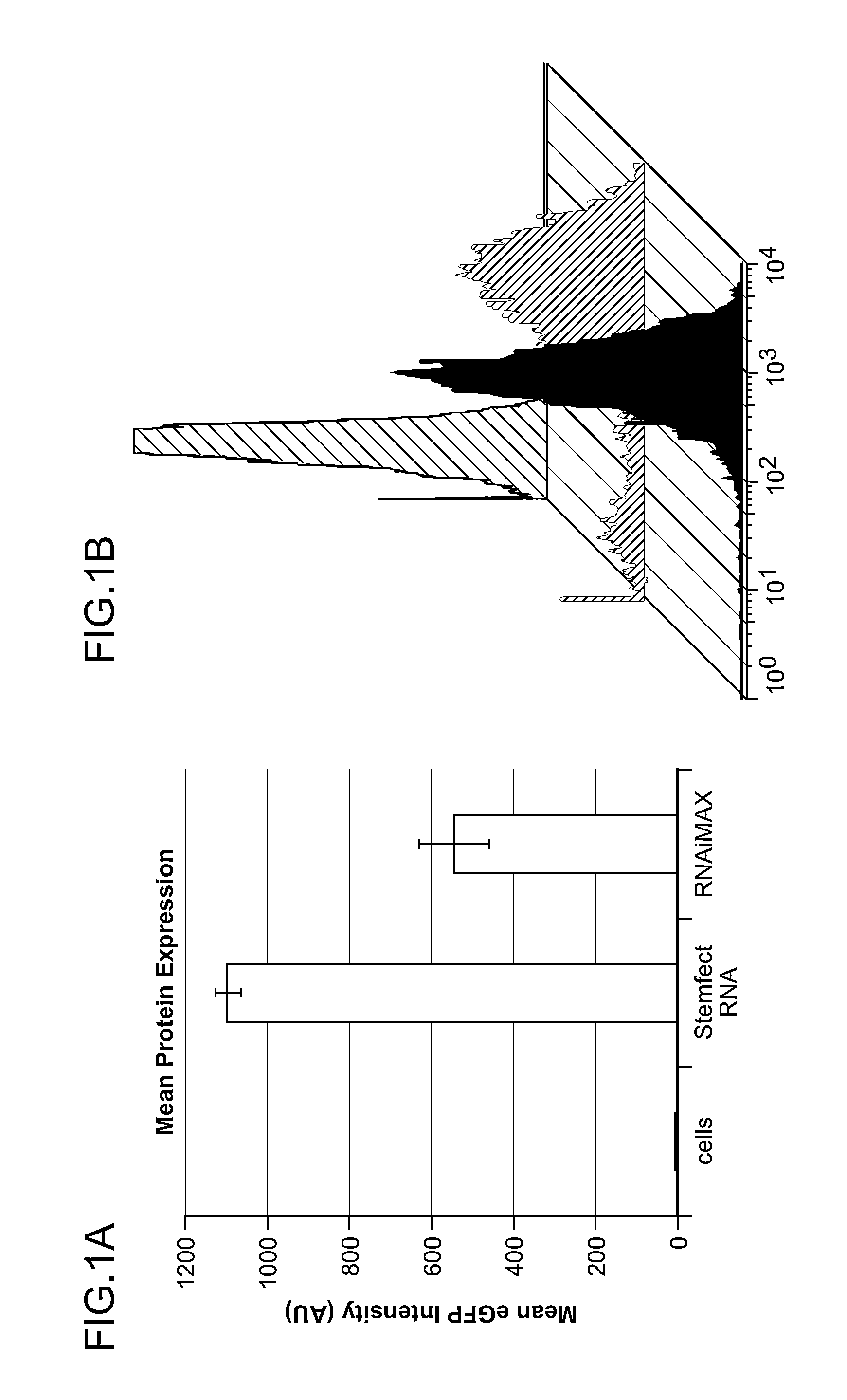Methods of preparing pluripotent stem cells
- Summary
- Abstract
- Description
- Claims
- Application Information
AI Technical Summary
Benefits of technology
Problems solved by technology
Method used
Image
Examples
example 1
Transfection of eGFP mRNA Using the Stemfect™ RNA Transfection Kit
[0214]FIGS. 1A-C demonstrate the results of experiments wherein fibroblasts are transfected with eGFP mRNA using the Stemfect™ RNA Transfection Kit. BJ fibroblast cells (fibroblasts derived from human foreskin that are not mature) were seeded in a 24-well format and transfected with 250 ng of eGFP mRNA. The cells were cultured at 37° C. and 5% CO2 and analyzed by flow cytometry at 18-24 hours post-transfection. FIG. 1A is a graph demonstrating the mean fluorescence intensity as determined by flow cytometry. Stemfect™ RNA Transfection Kit yielded 2-3 fold higher average protein expression than that observed using RNAiMAX™. FIG. 1B presents representative histograms comparing the transfection efficiency of Stemfect™ RNA Transfection Kit (purple) to RNAiMAX™ (green) alongside an untransfected cells control (red). Stemfect™ Transfection Kit led to >98% transfection efficiency of eGFP mRNA without any significant toxicity,...
example 2
Derivation of Integration-Free iPS Cells from Primary Patient Fibroblasts in a Feeder-Free Environment
[0216]iPS cells of the invention are generated from primary patient fibroblasts in a feeder-free environment.
[0217]The Experimental timeline for production of iPS cells from primary patient fibroblasts in a feeder free environment is presented in FIG. 2A.
[0218]Experimental Timeline:
[0219]On day 1, 50,000 human fibroblasts were seeded in a single well of a 6-well plate, pre-coated with Matrigel™ and cultured overnight at 37° C., 5% CO2, and 21% O2. During days 0-12 target fibroblasts were transfected in medium previously conditioned with NuFFs (Human Newborn Foreskin Fibroblasts). The cells were transfected with miRNA and mRNA cocktail of the invention (for example, Cluster A or Cluster B) as follows:
[0220]Day 0-pluripotency miRNA cocktail;
[0221]Days 1-3-1.5 μg of mRNA cocktail (OSKML-Oct4, Sox2, Klf4, Myc and Lin28);
[0222]Day 4 □both mRNA and miRNA cocktails (sequentially added);
[02...
example 3
Number of Transfections Required for Generating iPS Cell Colonies
[0227]The number of transfections required for generating iPS cell colonies when transfecting with an mRNA cocktail only was determined. Two patient derived human dermal fibroblast cultures were each seeded at 50,000 cells in one well of a Matrigel™ coated 6-well plate and cultured overnight at 37° C., 5% CO2, and 21% O2. Cells were transfected daily with 1.5 μg of mRNA reprogramming cocktail in Pluriton™ Reprogramming Medium for the indicated number of days (see FIG. 4) and incubated overnight at 37° C., 5% CO2, and 21% O2. After completing the transfections, the media was changed daily until Day 12. Each well was then individually stained with Stemgent StainAlive™ (Stemgent) TRA-1-81 Antibody for iPS cell colony identification to assess reprogramming productivity at Day 12. Colonies emerged in wells receiving as few as 6 transfections. Maximal iPS cell colony productivity was observed when primary patient fibroblasts...
PUM
| Property | Measurement | Unit |
|---|---|---|
| Fraction | aaaaa | aaaaa |
| Fraction | aaaaa | aaaaa |
| Fraction | aaaaa | aaaaa |
Abstract
Description
Claims
Application Information
 Login to View More
Login to View More - R&D
- Intellectual Property
- Life Sciences
- Materials
- Tech Scout
- Unparalleled Data Quality
- Higher Quality Content
- 60% Fewer Hallucinations
Browse by: Latest US Patents, China's latest patents, Technical Efficacy Thesaurus, Application Domain, Technology Topic, Popular Technical Reports.
© 2025 PatSnap. All rights reserved.Legal|Privacy policy|Modern Slavery Act Transparency Statement|Sitemap|About US| Contact US: help@patsnap.com



